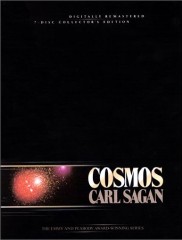Cosmos
 I received a copy of Cosmos on DVD from my brother for Christmas — too late for me to blog about it as part of the Carl Sagan blog-a-thon that took place on December 20, the tenth anniversary of his death, but here it is belatedly.
I received a copy of Cosmos on DVD from my brother for Christmas — too late for me to blog about it as part of the Carl Sagan blog-a-thon that took place on December 20, the tenth anniversary of his death, but here it is belatedly.
It’s safe to say that I grew up on Cosmos: portions of the series have persisted in my memory since it was first broadcast (when I was eight); I also had a copy of the companion book which I have since, I guess, lost. It made a big impact on my impressionable mind, but only in its discrete parts; it was only now, when I was able to watch the series, beginning to end, as an adult, that I was able to appreciate the whole.
Sagan was making an argument with this series, and each episode, and each point within each episode, illustrated with an historical analogy or with a simple demonstration, contributed to that argument. To point out that complex organic molecules are easy to make, and that the laws of science — of physics and chemistry — are the same throughout the universe, is to support the argument that life on other worlds is not only possible, but probable. A parallel argument is our connectedness to the greater universe: how, for example, supernovae essentially built us, by providing our planet’s heavy elements and the cosmic rays that enable mutation-driven evolution. And so forth. This was never a mere science program, or even a science program with a lot of neat material on the history of science.
One unexpected reaction — we must be getting old — was that despite our strong interest in the series’s subject matter, Jennifer (and I, to a lesser extent) had real trouble staying awake. PBS programming was slower paced in 1980, and Sagan’s manner of speaking and tone was surprisingly soothing.